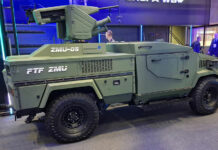 Among the aviation programs promoted at the 2007 Modern Day Marine expo were the new CH-53K Sikorsky, and FireScout Vertical Takeoff and Landing Unmanned Aerial Vehicle (VT-UAV) from Northrop Grumman, which was presented for the first time as a weaponized platform, loaded with a quad launcher carrying Viper Strike weapons. Models of Sikorsky’s future helicopter versions based on the X2 coaxial rotor propulsion system included a VT-UAV, an attack helicopter which could become a future successor for the AH-1W Cobra and an assault helicopter platform, a potential successor to the UH-60 helicopter.
Among the aviation programs promoted at the 2007 Modern Day Marine expo were the new CH-53K Sikorsky, and FireScout Vertical Takeoff and Landing Unmanned Aerial Vehicle (VT-UAV) from Northrop Grumman, which was presented for the first time as a weaponized platform, loaded with a quad launcher carrying Viper Strike weapons. Models of Sikorsky’s future helicopter versions based on the X2 coaxial rotor propulsion system included a VT-UAV, an attack helicopter which could become a future successor for the AH-1W Cobra and an assault helicopter platform, a potential successor to the UH-60 helicopter. 
 A new concept from Boeing highlighted a future pulsejet powered hevy lift VTOL platform, capable of carrying medium armored vehicles weighing up to 30 tons. Advanced PulseJet Vertical Lifters Boeing is studying a vertical take-off and landing (VTOL) aircraft that could lift heavy payloads of up to 30 tons, utilizing innovative ‘advanced pulsejet’ propulsion. While basic pulsejet is well understood (it was implemented in the 1940s with the V-1 flying bombs) Boeing patented this concept for vertical takeoff and lending applications, combining separate axial and vertical propulsion sources. The vertical propulsion source includes pulsejet engines located in separate augmentor bays fitted with having apertured walls to equalize pulsejet thrust. Embedded within the aircraft structure, multiple PulseJet engines ‘banks’ will be used to control the aircraft attitude, ascent and pitch and support the structural loads. By using separate axial and vertical thrust sources and pulsejet engines for vertical thrust, aircraft speed, payload and operating range are improved while a loss of one or more lift engines is mitigated by the remaining engines offering redundant and resilient VTOL capability over any terrain. According to Boeing, typical operating distance of such aircraft could be in the 500 – 1,500 nm range, cruising at a speed of 300 – 450 mph. Boeing considers various platforms utilizing the novel VTOL propulsion, including manned aircraft lifting payloads of 20 – 30 tons, and small manned or unmanned platforms, lifting payloads of 1,500 – 10,000 lbs (0.75 – 5 tons).
A new concept from Boeing highlighted a future pulsejet powered hevy lift VTOL platform, capable of carrying medium armored vehicles weighing up to 30 tons. Advanced PulseJet Vertical Lifters Boeing is studying a vertical take-off and landing (VTOL) aircraft that could lift heavy payloads of up to 30 tons, utilizing innovative ‘advanced pulsejet’ propulsion. While basic pulsejet is well understood (it was implemented in the 1940s with the V-1 flying bombs) Boeing patented this concept for vertical takeoff and lending applications, combining separate axial and vertical propulsion sources. The vertical propulsion source includes pulsejet engines located in separate augmentor bays fitted with having apertured walls to equalize pulsejet thrust. Embedded within the aircraft structure, multiple PulseJet engines ‘banks’ will be used to control the aircraft attitude, ascent and pitch and support the structural loads. By using separate axial and vertical thrust sources and pulsejet engines for vertical thrust, aircraft speed, payload and operating range are improved while a loss of one or more lift engines is mitigated by the remaining engines offering redundant and resilient VTOL capability over any terrain. According to Boeing, typical operating distance of such aircraft could be in the 500 – 1,500 nm range, cruising at a speed of 300 – 450 mph. Boeing considers various platforms utilizing the novel VTOL propulsion, including manned aircraft lifting payloads of 20 – 30 tons, and small manned or unmanned platforms, lifting payloads of 1,500 – 10,000 lbs (0.75 – 5 tons).
 X2 VT-UAV
X2 VT-UAV
Sikorsky released preliminary details about a new unmanned aerial vehicle designed for vertical take-off and landing (VT-UAV) based on its latest X2 technology. The helicopter-like attributes and high speed (up to 250 kt cruise speed) enable multi-mission flexibility and grouth potential. This aircraft will be designed to carry mission equipment payloads of 300 lbs at a maximum gross takeoff weight of 5,600 lbs. (enhanced up to 6,200 lbs GTOW). The vehicle will utilize Sikorsky’s X-2 technology comprising twin four-blade counter rotating rotors and a pusher propeller, both powered by a single 1,800 shp engine. The VT-UAV will be able to operate autonomously at ranges of 200 nm, performing ISR missions of 4 hours (time on station). Alternatively, an armed/attack version could carry 14 advanced precision kill weapons (APKWS) or four Hellfire missiles on armed recce missions or perform crisply missions, carrying up to 1,000 lbs or cargo over 100 nm radius of action.
Other topics covered in this review:
- Light but Protected – Near-term HMMWV Replacements
- Bull Offers Maximum protection
- Gearing Up For the Joint Light Tactical vehicle
- JLTV Pathfinder – Combat Tactical Vehicle
- Hybrid Electric JLTV
- Specialized Off-Road Mobility
- Protecting against Blast
- HMMWV Accessories and Upgrades
- Vehicle Recovery in Combat
- Command and Control Systems
- Unmanned Ground Systems & Robotics
- Remote Weapon Systems
- Panoramic Vision Systems
- Advanced Technology for Future Vertical Lift
- Counter IED Technologies
- Weapons & Personal Gear















